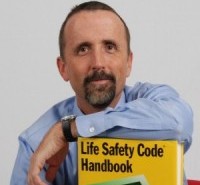Painting sprinkler heads, can you paint the fire sprinkler’s head, can you paint the sprinkler head escutcheon or cover plate.
Category: Fire Protection
ARE, Extinguisher, Fire Extinguisher Labeling, Fire Protection
Fire Extinguisher Labeling 25-0
by Marty •
Fire extinguisher classifications/labeling what kind of fire extinguisher to put out your standard home fires. What kind of extinguisher will put out ordinary wood and clothing and what kind of fire extinguisher is best for only electrical fires. Is there a special fire extinguisher for MRI, yes the housing should be nonferrous/non-magnetic.
Building Code, Door, Exit, Exiting, Fire Protection, stair Design, Type of Construction
Door & Shutter Protection Rating 24-0
by Marty •
Door and shutter assembly ratings it’s not just the door that has to be rated it’s the entire assembly. This video reviews the wall rating and what the assembly rating should be.
ADA, Building Code, Common Path, Door, Exit, Exiting, Fire Protection, Horizontal Exit, occupant Load, Occupant type, stair Design
Panic or Fire Hardware 21-0
by Marty •
Panic or fire hardware, panic hardware at exit doors and/or out of other spaces is what this video covers. Panic hardware is used more times than it is required. It’s probably only required about half the time that I see it used. Only required in H occupancies or A or E spaces or occupancies, Where those occupancies are over 50 persons.
ADA, Building Code, Door, Exiting, Fire Protection
Door Closer 20-0
by Marty •
Automatic door closing device,Door closer, where there required. Any room or space that requires a rating or at one time required a rating and the sprinkler exemption was taken to not have to rate that room. Door closer is still required for that space. Healthcare, since that is my design background, places more door closers than are required by either code in order to help facilitate the facilities of actuation plan.
ARE, Building Code, Building Size, Concrete, Fire Protection, Steel, Type of Construction
Type of Construction 16-0
by Marty •
Type of construction table 601 and NFPA 220 both speak to the types of material you’re allowed to use. Both of these tables and sections relate to other sections of the code that speaks to how big or how tall your allowed to build building. For instance code wise you’re not allowed to build a building out of wood if it’s over a certain amount of square footage. Likewise you not allowed to use would be the building of different heights in concealed spaces i.e. your on allowed to build your Interior partition walls of wood on a high-rise. This table does not speak to those locations it only gives you the definition of the building types. Table 503 speaks to hide insights that directly relates to take 601.
Building Code, Door, Exiting, Fire Protection, occupant Load
Door Locations 15-0
by Marty •
I will be updating this video soon, It was just pointed out to me that I say and show “1/2 divided by D” it should be “1/2 * D” for your trying to get 1/2 the distance of D for a not sprinkled building. for a sprinkled it would be 1/3. I will get this corrected soon. This video is on where doors you be located in a room where the occupied requires more than one door. Most occupancies that threshold is 49 people. Once that threshold is met two doors are required and a shout be remotely located from each other. Storage occupancies the threshold is 29, institutional occupancies most are around 10, hazard three people require you to have more than one door but with hazard on doors shall swing in the direction of travel.
ARE, Building Code, Exiting, Fire Protection
Fire Extinguishers Locations 14-0
by Marty •
Fire extinguishers and their locations. The matter how you look at this is going to cost someone money. Fire extinguishers are required to be inspected monthly, documented for both local and federal agencies depending on the type of building our occupancy you have. Healthcare for instance with all the regulations they need to follow, fire extinguishers on average cost $500-$800 per year just for inspections. So an architect or engineer placing too many fire extinguishers in the building can easily cost the owner quite a bit more money. At a facility I reviewed a few years ago we counted between 15 and 25 more fire extinguishers per floor them they needed. They had five floors that is about 125 more fire extinguishers than required assuming the minimum amount of dollars for inspection, $500, this equates to about $62,000 per year for inspections only a fire extinguisher is not required or needed. This is an ongoing cost, so in 10 years this is easily $620,000 that could have been spent better for our healthcare facilities. Take time to analyze every fire extinguisher removed those that are not needed or required. This all needs to be documented with your local AHJ. This can be done at any time you discover you have too many. But the whole floor or area should be analyzed as a whole.
Alarm, Building Code, Dead End, Fire Protection, Strobe, Visible Alarm
Fire Alarm Strobe / Visible Alarm 12-0
by Marty •
Fire alarm strobe and placement visual fire alarm based on requirements from both IBC and NFPA, this video can be helpful to fire alarm designers architects for placing artwork and understanding and building officials and fire Marshall’s
Fire Protection, Travel distance
Standpipe locations 4-0
by Marty •
Standpipe’s, should be located within 200 feet of each other. This is easy to achieve mentally and I-2 occupancy, healthcare since travel distance to annex it is also 200 feet and most panpipes are located inside of stairwells. In be occupancy or travel distance is 300 feet to an exit, additional standpipe’s may be required are required so that the standpipe could be reached within 200 feet
